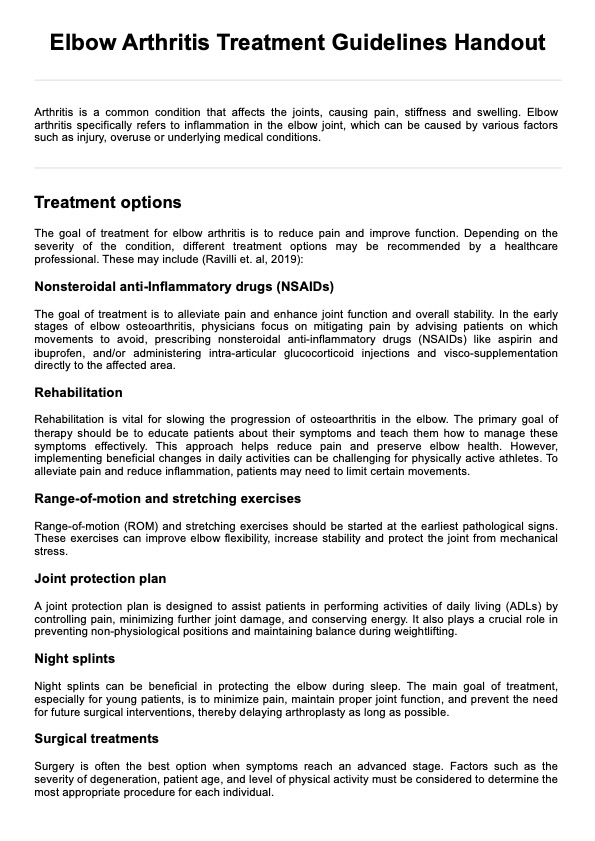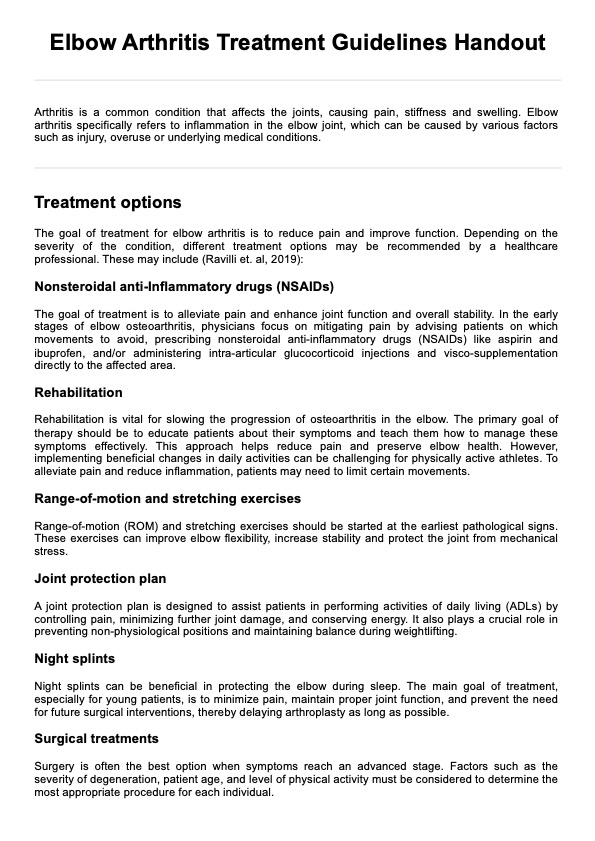Elbow Arthritis Treatment Guidelines Handout
Discover the guidelines for elbow arthritis treatment. Download this free PDF guide for effective treatment options and management strategies.


What is elbow arthritis?
Elbow arthritis is a condition characterized by inflammation of the elbow joint space, leading to pain and stiffness. The elbow is a hinge joint formed by the humerus, radius, and ulna bones, enabling a wide range of motion. The effect of arthritis on afflicted joints can significantly impact daily activities and function.
Common symptoms of elbow arthritis include persistent elbow pain, swelling, and reduced range of motion. The condition commonly occurs from various causes, such as rheumatoid arthritis, where the immune system attacks healthy joint tissue or soft tissues, or post-traumatic arthritis, which develops after an injury.
Diagnosis in early stages and appropriate management are crucial to prevent further elbow joint damage. Medical evaluation, like magnetic resonance imaging, by a healthcare professional is recommended for accurate diagnosis and personalized treatment planning.
Elbow Arthritis Treatment Guidelines Handout Template
Elbow Arthritis Treatment Guidelines Handout Example
How to treat elbow arthritis
Treating elbow arthritis involves a multifaceted approach to managing symptoms, relieving elbow pain, and improving the functionality of the elbow joint. Various treatment options are available, depending on the severity of the condition and individual needs. Below are some effective ways to treat elbow arthritis.
Physical therapy
Physical therapy is a common and effective treatment for elbow arthritis. It focuses on exercises that enhance the range of motion, strengthen the muscles around the elbow joint, and improve overall flexibility. By targeting the specific symptoms of elbow arthritis, physical therapy can help relieve pain and inflammation, providing significant pain relief.
Medications
Medications play a crucial role in managing elbow arthritis symptoms. Nonsteroidal anti-inflammatory drugs (NSAIDs) can help reduce pain and inflammation. In cases of rheumatoid arthritis, disease-modifying antirheumatic drugs (DMARDs) are often prescribed to slow the disease's progression. Corticosteroid injections can provide quick pain relief by reducing inflammation in the elbow joint.
Surgical options
For severe cases of elbow arthritis where other conservative treatments have failed, surgical options may be considered. Total elbow replacement surgery, or total elbow replacement, involves replacing the damaged parts of the elbow joint with artificial components. Elbow replacement is particularly beneficial for individuals with advanced arthritis or significant bone spurs that interfere with joint movement.
Lifestyle modifications
Maintaining a healthy weight reduces the strain on the elbow joint while avoiding activities that exacerbate bone spurs and elbow pain can prevent further damage. Using ergonomic tools and supports can also alleviate stress on the ulnar nerve and improve joint function.
How to use our treatment guidelines handout
Carepatron's treatment guidelines handout is designed to assist orthopaedic specialists in effectively managing elbow arthritis. Here's how you can use the handout:
Step 1: Download and review the template
Start by clicking the download button on this page. Review the template sections, which cover the basics of elbow arthritis, symptoms, treatment options like physical therapy and medications, and when to consider surgical interventions such as elbow replacement surgery.
Step 2: Use as a resource
Use the template alongside other resources to meet the specific needs of your patient. Use details about their medical history, diagnosis, and symptoms of elbow arthritis to form a personalized treatment plan. Highlight key aspects like pain relief strategies, recommended exercises, and any prescribed medications or injections.
Step 3: Educate your patient
Use the handout during consultations to educate your patient about their medical condition. Explain the importance of each treatment option, from lifestyle modifications to potential surgical procedures, and how these can help relieve pain and improve elbow joint function.
Step 4: Provide follow-up care
Incorporate the handout into your follow-up care strategy. Ensure patients understand the steps they need to take, including attending physical therapy sessions and adhering to medication regimens, to reduce pain and improve their range of motion.
Benefits of using this handout
Carepatron's treatment guidelines handout offers medical professionals managing elbow arthritis several key benefits. First, it ensures consistent and structured patient education on diagnosis, treatment options, and self-care practices, promoting better patient understanding and adherence to treatment plans.
The handout also enhances communication between healthcare providers and patients, empowering patients to actively participate in their care decisions. This resource also saves time by streamlining the educational process during consultations, improving clinic efficiency.
Incorporating Carepatron's handout into practice enhances patient care, optimizes workflow, and leads to better outcomes in managing elbow arthritis. Start using this resource today to streamline your practice and improve patient education and outcomes.
Commonly asked questions
Treatment options include physical therapy to strengthen muscles and improve range of motion, medications like NSAIDs for pain relief, corticosteroid injections to reduce areas causing inflammation, and, in severe cases, elbow replacement surgery.
Gentle range-of-motion exercises, such as wrist curls and gentle stretching of the forearm muscles, can help maintain flexibility and reduce stiffness in arthritic elbows.
Managing arthritis involves maintaining a healthy weight, avoiding repetitive stress on the elbows, using ergonomic tools, and adhering to prescribed treatments like medications and physical therapy to reduce inflammation and preserve joint function.
Arthritis in the elbow is known for causing pain, stiffness, swelling, and reduced range of motion. It can also lead to a sensation of grinding or popping within the joint during movement.







































































































